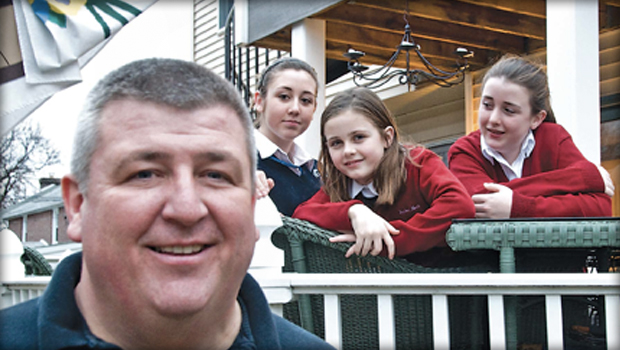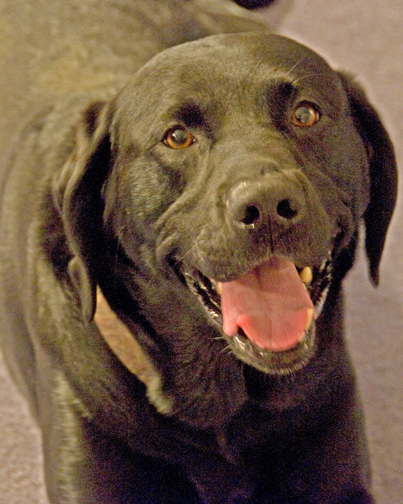Caption: Medic Jim McCans at home with daughters (left to right) Brenn, Killeen and Kerry | Photo © Katharine Gilbert
By Sabina Clarke
Where to begin with this remarkable story. It’s heroic fantasy that movies are made of. It is about Jim McCans, Director of Paramedics for Haverford Township—a brave man who is all heart and Stache, his equally courageous black Labrador retriever ‘cadaver’ dog.
This past October, Stache was honored by the ASPCA (American Society for the Prevention of Cruelty to Animals) at its annual Humane Awards luncheon and presented with the Presidential Service Award for his ‘remarkable service to humans.”
Jim McCans, at forty-four, is too young to have served in Vietnam and had never seen war close up, yet he didn’t hesitate when he got the call from U.S. Central Command in Iraq. A ‘cadaver’ dog was needed to find two missing GIs from New York. So, in October 2007, McCans and Stache, assigned to the 101st Airborne Division of the U.S. Army headed to Iraq where they stayed for two months at Victory Base Compound, seventy-five feet from the wall separating them from Baghdad.
He remembers the last forty-five minutes of his flight crossing into the country with all the lights going off the plane including the exit lights, “There was no light on the airplane as it spiraled into the airport and flew around in circles until it got real low and on the last circle landed on the runway. Everything was camouflaged as people ran towards us and rushed us off the plane. Even the sand was grey and dirty. It was prehistoric.”
Eighteen hours later, McCans and Stache were on a mission searching for human remains in caves deep in the desert. It was then he realized he was “outside the wire” outside where it was safe—“A lot of the soldiers over there said, ‘Oh yeah, I wouldn’t go outside the wire because ‘it’s frightening enough in here.’”
He had a brush with death in early November when an IED (improvised explosive device) detonated in front of his platoon in Owesat, Iraq. Two soldiers, part of his protection detail, Sergeant Chris Payne and Sergeant Rob Laux were severely injured. McCans too was disoriented and temporarily lost his speech and eyesight. His dog Stache, hit by shrapnel, suffered a ruptured eardrum and temporary hearing loss.
As he tried to come to the aid of the wounded soldiers, McCans was ordered to get down by the Chief Officer because there were ‘secondaries’ or more IEDs in the area. Although the command ran counter to his instincts as a medic, he obeyed. Yet, he still holds on to his frustration at not being able to help his wounded buddies.
He recalls what happened next, “Within seconds the rest of the platoon came to our aid and the medic in the group took over–as good or better than any trauma sergeant I’ve ever seen. By the time the blast went off and when the helicopter took off with the wounded soldiers, it was 11 minutes. That beats what I do here in the US.”
Bounty on Dog Teams
Stache, who graduated with a perfect score in his twelve week training class at the police academy, had nine finds in Iraq. He found graves in caves that were eight feet deep where soldiers had been cremated and buried. A playful dog with tons of personality, he was popular with the GIs but feared by the Iraqis who believe that black dogs are satanic—“Iraqis were very afraid of Stache because he is black. They thought he was extremely satanic so they viewed me with suspicion also since I talk to Stache. In Iraq, dogs are not kept as pets and all dog teams have a bounty on them of $85, 000 if they are killed.”
Of his Iraq experience, he says, “I was frightened to death. It was the most frightening place I could imagine. It was sheer terror–period. It is the most terrifying place on the planet. On one of our first missions in Samarra, an Iraqi police officer was badly wounded. On the way back to the base, we rode in an IED clearing vehicle. My nerves were shot.”
Stache made AOH mascot
This past October, Jim McCans was invited to speak about his Iraq experience by the Dennis Kelly Chapter of the AOH (Ancient Order of Hibernians) Division One in Havertown. His wounded buddies, Chris Payne and Rob Laux, whom he had not seen since the blast in Iraq, got a leave from Walter Reed Hospital where they were patients to be the guests of honor at this AOH fundraiser, Operation Home Front, which benefits returning US soldiers.
Toward the end of the evening, McCans’ wife Kathie, a pediatrician and expert authority in child abuse, brought Stache to the event. “Everyone,” said McCans “was in tears.” McCans was inducted as an honorary member into the AOH and Stache was named as their mascot.
Flight Paramedic for PennSTAR
In addition to his full-time job as Director of Paramedics for Haverford Township, he is a critical care flight medic for PennSTAR, the University of Pennsylvania’s critical care helicopter. Mc Cans was on PennSTAR’s 1988 inaugural crew—one year after CBS show 60 Minutes did an investigation on the high crash rate of helicopters. His calls on PennSTAR are varied with half of them pre-hospital cases: “We get all kinds of cases-anything from car accidents to gun shot wounds to suicides to flying out surgical teams for a transplant. You wouldn’t believe some of the bizarre ways people get injured. We get people who electrocute themselves by putting up Christmas tree lights and people needing cardiac catheterization.”
McCans was bitten by the ‘rescue’ bug at 16 when he signed up as a volunteer firefighter for Manoa Fire Company and rode in an ambulance as well as the fire truck. He trained to become an emergency medical technician (EMT) and went on to become a paramedic.
Chester: A Baptism of Fire
His first job was in Chester, Pa—a challenge for a 19 year old from Havertown, “the land of milk and honey is what the other medics called it.” He remembers a drug deal gone bad in a bar. The owner of the bar exchanged bullets with the robber and chased him into the bathroom-“ I remember looking at the owner who was shot, knowing that he couldn’t distinguish me from the robber and grabbing the gun from him and handing it to the police officer. Then we got him to the hospital and he passed away an hour later. When the robber was on trial, I was scared to death because I had to testify in court.”
Another time he was called to the apartment of two brothers in their sixties. “I still remember their names: Arthur and Luther. They lived together and always fought with each other. One brother hit the other with a bed slat and the other brother threw a pot of boiling eggs at the brother who hit him with the bed slat. One had his head split open and the other had flesh hanging off him.” Laughing at the absurdity of it all, he says, “I had to put them both in the ambulance-at opposite ends of each other.”
On Call for Hurricane Katrina
Several years ago, when Hurricane Katrina hit, McCans was contacted by PEMA ( Pennsylvania Emergency Management Association) to go to Mississippi with his ‘cadaver’ dog Stache and look for dead bodies.—“ Stache and I spent nine days there looking for people in Kiln, Mississippi.”
FBI Swat Team in Philadelphia
And as the lead tactical medic for the FBI for the past 10 years whenever there is a SWAT call-out, he covers an area that includes a portion of South Jersey, a portion of Delaware and a portion of Pennsylvania and part of the district that bumps up against the District of Buffalo, “We’ve dealt with hate groups, with illegal guns sales, with bank robbers and shootings. We’ve done all kinds of cases from arms being shipped from different parts of the world to high risk warrants for people wanted for homicide.” On a SWAT call, he wears a bullet proof vest and a helmet but doesn’t carry a gun. However, he feels much protected. He was part of the detail at the Army-Navy game right after 9/11 and at the Little League World Series in Williamsport, Pa.-an international high profile event. And he is assigned to the FBI detail for President-Elect Obama’s inauguration in Washington, D.C. in January.
With all this action, McCans still found time to complete his education and get a BA in Liberal Arts from Neumann College in Aston, Pa. and a Masters Degree in Forensic Medicine from Philadelphia College of Osteopathic Medicine (PCOM).
At PCOM, he was invited to join the faculty as an assistant professor in the department of Pathology, Microbiology, Immunology and Forensic Medicine. He taught a class in Forensic Medicine at PCOM from July 2004 to May 2008.
Will Jim McCans, action hero, emergency medical director, flight paramedic, FBI lead tactical medic, Iraq veteran and college professor go back to Iraq if he gets the call? “I’d like to think I don’t have to go back but I can’t bear the thought of leaving somebody there.”
Move over Indiana Jones.


